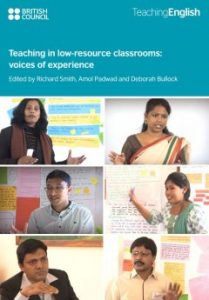Book Review: Edited by Richard Smith, Amol Padwad and Deborah Bullock
produced by the British Council.
 This review written by Lina Gordyshevkaya won first prize in a competition for best book reviewer organized by the British Council
This review written by Lina Gordyshevkaya won first prize in a competition for best book reviewer organized by the British Council
Think of your latest lesson. How many students were there in the classroom? Did they have any materials, i.e., textbooks or handouts? What did the classroom itself look like? As for me, in my latest lesson, I had nine students who were studying academic discussion using the prescribed textbook in a big room equipped with the whiteboard and OHP. You see, I am one of those teachers who happens to teach in a so-called ‘privileged setting’. A setting that one will hardly find in the classrooms across India, Nepal, Pakistan, or Bangladesh.
- How to teach a class of over 100 students
- How to handle two classes at one time
- How to teach a reading-based course with no texts provided
These and many other questions that many of us have probably never even thought about are not only asked but also answered in this book. It has just 68 pages yet every single page is a treasure island for any teacher, disregarding the setting they teach in.
The Introduction guides the reader through the process of how this book was created. It briefly explains its purpose and describes what one can face when teaching in a low-resource classroom. It continues with a detailed outline of a workshop organised by Hornby Regional School with the additional assistance of the British Council in Nepal. The workshop consisted of two parts; Stories of Success and Stories of Teacher-Inquiry and the book is divided into two parts based on these two topics.
In the first part, you can find stories in which teachers share all the details of their successful teaching. These eighteen stories that are so independent of each other but still have one thing in common: these are stories about making a difference. They show that one needs neither textbooks nor modern high-equipped classrooms to motivate students and involve them in the learning process. The only things needed are passion, persistence and willingness to help and love. Kiran Gogoi, the author of a story called Attitude is everything, says:
“The teacher who can think and see the world through their [students’] eyes will love them, and this love can help us become better teachers.” (p. 24).
All stories in the first part teach you that the main ingredient of successful teaching is to motivate students and make them interested in what you are saying. It explains the need to involve them so that they become curious and start asking questions. Make them work together, unite them and give them the sense of belonging.
These are basic and widely-researched things that I am sure everyone knows yet how many of us are doing it every day in every single lesson?
To be honest, I am not sure I do it as often as I probably should. How often I feel that my best intentions get lost among the course requirements, fights with the clock (oh these ticking enemies of all teachers on this planet!) and all other tiny but significant things I think I have to do in the first place. Are they that important though? These nineteen stories showed me that there are things more important and vital to the essence of teaching. Instead of just knowing that something has to be changed I now understand what exactly has to be changed.
I feel inspired, and, in my opinion, inspiration is one of the most important things that push us forward. The changes we do might be just ‘a drop in the ocean’ as Fehmina Quaiser, the author of Creating a ‘garage school’ story, said, but many drops become an ocean, don’t they?
The second part of the book is dedicated to some major problems the teachers face while teaching in low-resource classrooms and their possible solutions. Teachers here united in small groups and explored different issues, e.g., correcting written work in large classes, teaching students from diverse backgrounds, using L1 in the classroom, etc. Each story has a clear structure and gives an overview of the essence of an issue, some solutions that were tried out and teachers’ reflections on the results.
Therefore, the stories offer an in-depth analysis along with practical advice on managing similar problems in case they occur in your classroom, and since each story in this section presents a wide range of different solutions, there are enough strategies to choose from. Personally, I found many of them quite handy including those that seem to have no connection to my current teaching setting. I am sure every reader will be able to say the same after being acquainted with this section of the book.
Overall, this piece of work can be described as inspiring and practical, which, in my opinion, are two qualities of a truly useful handbook. Another feature worth mentioning is that apart from being highly practical, each story in both sections is followed by two reflection questions so that this book can be easily used as a tool for professional development.
I would recommend reading Teaching in Low Resource Classrooms to those teachers who are looking for action plans they can implement in their classrooms. People who are seeking for a source of inspiration and some moral support are welcome as well; this book will hardly leave any reader indifferent to the stories it tells.
I believe there is a risk for me of getting too emotional, but I must admit: the fantastic teachers who made it happen are my heroes.






